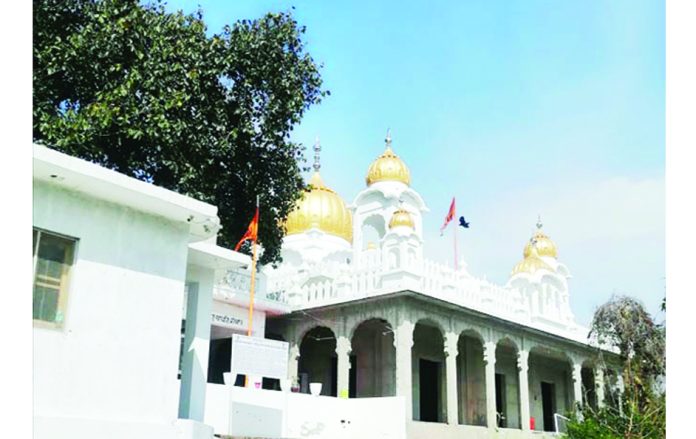Dr Jasbir Singh Sarna
Guru Nanak, the founder of the Sikh religion, indeed left an indelible mark on history through his extensive travels and profound teachings encapsulated in his Bani.
His journey spanned thousands of miles, traversing diverse terrains and encountering various cultures and peoples. The verse “Waho Waho Bani Nirankar hai, Tis Jevad Avar Na Koi” underscores the transcendental nature of his teachings, emphasizing their uniqueness and universal relevance. The suggested route of Guru Nanak’s travels offers a glimpse into the arduous journey undertaken by the Guru. Starting from Kiratpur Sahib, he embarked on a pilgrimage that took him through Batala, Jasrota, Rwalsar, Purmandal, and beyond. Each stop along the way provided opportunities for spiritual discourse, enlightenment, and the dispelling of superstitions and false beliefs. Notably, his interactions with saints and common folk alike served to unite people under the banner of Akal Purakh, the timeless and formless divine.
This journey from inception to fruition exemplifies the enduring spirit of communal devotion and underscores the importance of preserving and perpetuating the rich cultural and religious heritage embodied by Guru Nanak Dev Ji. Through collaborative efforts and unwavering dedication, the establishment of the Gurdwara stands as a testament to the enduring legacy of Guru Nanak Dev Ji and the values he espoused.
Among the notable stops along his journey, Bakhta (Jasrota) holds a special significance. Here, Guru Nanak rested beneath a Pipal tree (Ficus religiosa) , engaging in profound discussions with local pirs and liberating them from their superstitions. This encounter underscores Guru Nanak’s commitment to fostering spiritual enlightenment and breaking barriers of ignorance.
The enduring presence of the Pipal tree serves as a tangible reminder of Guru Nanak’s spiritual legacy, attracting pilgrims seeking solace and healing from afflictions.
During Master Gurnam Singh’s tenure as a teacher at the local school, he was apprised by fellow educators about the historical significance of Guru Nanak Dev Ji’s visit to the village of Bakhta. Notably, the proprietor of this revered site was Takhar Hurmit Singh Rajput. An annual tradition observed by the local populace involved the preparation and distribution of Sweet Chapatis on every Baisakhi day, symbolizing a communal celebration deeply rooted in tradition. In 1998, Master Gurnam Singh took the initiative to inform the Shiromani Gurdwara Parbandhak Committee (SGPC) in Amritsar about this sacred site. Subsequently, on January 2, 1999, the Director In-charge of SGPC approved the proposal. This pivotal decision paved the way for the establishment of the Guru Nanak Dev Ji Religious and Charitable Trust, comprising ten nominated members. The Trust, under its auspices, acquired three kanals of land from Thakar Hurmat Singh for a sum of 12 lakhs. Additionally, as a heartfelt gesture, one kanal of land was generously donated by Thakar Hurmat Singh in remembrance of his departed son. With a vision to honor Guru Nanak Dev Ji’s legacy, the Trust embarked on the construction of a Gurdwara, a sacred place of worship. The meticulous execution of this endeavor was overseen by Karsewa Baba Jasbir Singh, who dedicated his efforts to the realization of this noble cause. However, with the unfortunate passing of both Bhai Swarn Singh and Baba Jasbir Singh (Baba Bira) , the mantle of management transitioned to the District Gurdwara Parbandhak Committee, Kathua.
The enduring legacy of Thakur Hurmat Singh who relay the oral tradition passed down through generations, attests to the profound reverence surrounding the sacred Pipal tree purportedly belonging to Guru Nanak Dev Ji.
This revered site serves as a sanctuary for villagers, sought in times of affliction to alleviate suffering and ward off calamity. Its historical significance is underscored by its mention in Giani Gyan Singh’s seminal work, Tawarikh Guru Khalsa. Adorned by a historical shrine, the Pipal tree stands as a living testament to the spiritual legacy intertwined with the locale. Situated 9 km from the National Highway Rajbagh of Kathua, amidst the picturesque embrace of surrounding hills, the district offers a serene backdrop for pilgrimage. The establishment of Gurdwara Charan Kamal in Bakhta (Jasrota) further solidifies the historical significance of this site. It stands as a testament to Guru Nanak’s transformative presence and his enduring influence on the spiritual landscape of the region. The weekly gatherings at the Gurdwara, adorned by devotees, symbolize a continued reverence for Guru Nanak’s teachings and a vibrant community dedicated to his principles.
Guru Nanak’s extensive travels were not merely geographical expeditions but profound spiritual odysseys, shaping the spiritual consciousness of generations to come. His teachings continue to inspire millions worldwide, transcending boundaries of time, culture, and geography. Through meticulous documentation and reverence for historical sites associated with Guru Nanak, we ensure that his legacy endures, serving as a beacon of enlightenment and compassion for humanity.


